My grandfather was a history professor and Benjamin Franklin scholar. We grew up playing fun games with him - like giving him a random date and he'd tell us something cool that happened on that date, or he'd drop interesting tidbits about historical people, and we'd try to guess who they were - he built a love of history in us that has enriched our lives. Friends of mine recently penned a new book that I know he'd have loved: Philadelphia Liberty Trail: Trace the Path of America's Heritage. When I dug in, I was transported back in time - not only to historic Philadelphia, but to games about Benjamin Franklin and our country's history with my grandfather. What a gift this book is!
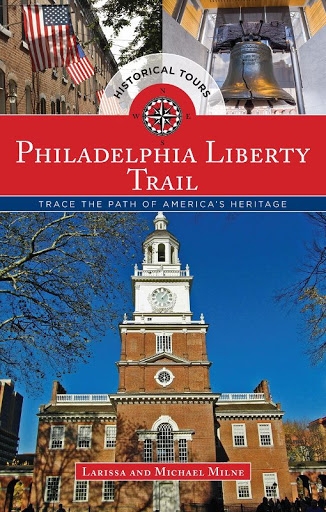
Larissa and Michael Milne (you will know them from their excellent site, ChangesInLongitude.com) have penned the most important guidebook to Philadelphia - one that you must read before visiting (and if you're anything like me, reading this book will inspire a visit to Philly!). Who better to write this book (and create the trail!) than award-winning native Philadelphian travel writers? I first became more interested in Philadelphia's history upon reading Dr. Mütter’s Marvels, about the Philadelphia doctor who changed the field of medicine by focusing on the good of the patient and finding ways to make the field of medicine better. I've since become more and more enamored with the history of this great city - and this book definitely satisfies my curiosity. It delves deeply into US history - and, much like my grandfather did, and gives stories and facts (such as the naming of Philadelphia - it's NOT named after William Penn (!), the story of the crack(s) in the Liberty Bell, or that Abraham Lincoln's body lay in rest in Independence Hall, the same place that our forefathers signed into law the Fugitive Slave Act - what stories these walls can tell!) that bring Philadelphia - and history - to life.

Independence Hall, the most historic building in America
The four-mile area of the Philadelphia Liberty Trail seems physically small, but it is jam-packed with history. The city is also modern - in one day, you can toss a penny onto Ben Franklin's grave, ride a carousel in Franklin Square, and eat well at Sonny's Famous Cheesesteaks. What I love about this book is that it, like Philadelphia, combines history and life today - through fun activities for kids (and their parents), good eats, and interesting tidbits about history that keep readers fascinated. This book is an extraordinary history lesson that is more than interesting - it's SO hard to put down. I'm extremely impressed with this book - highly recommended!
We were lucky enough to catch up with Larissa, and ask her about the book, inspiration, fostering a love for history, research, and more. Here's what she had to say...

Larissa and Michael Milne
Please tell us about your book, Philadelphia Liberty Trail…
It is a guidebook that takes a revolutionary approach to visiting Philadelphia’s historic district. Until now, there has been no single source that links the many historic sights here in the city that are related to the founding of America, and puts them into historical context. The book includes the “greatest hits” of the Liberty Bell, Independence Hall, and the Betsy Ross House, but then goes beyond that to lesser known sights that also have historic significance.
We learned all sorts of interesting historic tidbits as we were writing the book; they are sprinkled throughout the sight descriptions to bring the history to life. We also include “side trips,” which are sights of interest in the area that aren’t necessarily historic, like the US Mint, where you can watch coins being made.
We know it’s important not to overdo it when touring an area, so we made sure to include “pit stops” for travelers to rest weary feet and have a snack or lunch. (Michael is always a better traveler after he’s had a cookie!). We also designate destinations that are particularly “kid friendly” with a kite icon: these include historic sights, places for a snack, or even a few playgrounds to work off youthful energy.
We were thrilled that the Society of American Travel Writers selected it as one of the best new guidebooks of the year.

The story of how this book came about is so interesting - can you please share it?
We were approached by a publisher who wanted to create a book similar to one they have covering Boston’s Freedom Trail, an attraction that has been around for over 50 years. They assumed there was a similar trail in Philadelphia, but surprisingly there is NOT!
Since there was no trail to use as a template, we created one and named it Philadelphia Liberty Trail. In the process we discovered several terrific historic sights within walking distance of Independence Hall that many people totally miss.
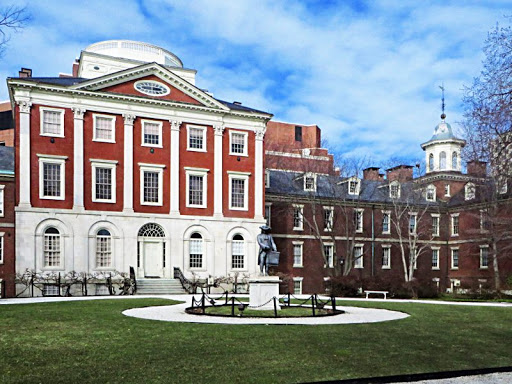
Pennsylvania Hospital, America’s oldest, founded in 1751
What led to your interest in history in Philadelphia?
We used to live only a few blocks from Independence Hall—it’s hard NOT to be interested in the history when you walk by such a significant building every day! The area we cover in our book has been described by many as “the most historic square mile in America” because so many major events and “firsts” occurred here.
How can parents and educators foster a love for history in their kids/students?
Visiting a destination where events actually took place brings history alive. We can lecture kids all day long about people and places that shaped the founding of America, and it may have minimal impact. But standing in the room where the Declaration of Independence was actually signed, imagining John Hancock sitting in that exact chair as he, Ben Franklin and others sweltered in the July heat to craft the most groundbreaking document in the world . . . that’s memorable.

This statue of Ben Franklin was made from the metal of melted keys donated by local schoolchildren
We love research! What was it like, researching your book?
It was fun, and sometimes very challenging. Since this book covers events that happened over 200 years ago there is a lot of information available, however not all of it is accurate. Something incorrect might have been written in 1850 and quoted and copied so many times since then that by now everyone simply assumes it’s true. When it came to historical facts, we needed to find multiple sources to verify the information or it wasn’t included in the book. If possible, we went back to original source documents, such as personal diaries, shipping manifests, etc.
We also reached out to known historians and scholars on specific subjects and sights, which was very helpful. They directed us to some obscure reference sources we might not otherwise have found, and provided us with historic tidbits that really added dimension to the history we were uncovering. In some cases they actually reviewed our draft copies for accuracy.
I would encourage anyone researching a topic to take this step. It might be intimidating to reach out to the expert on a given subject, but the reality is experts love discussing the topic that is their life’s work and are flattered that someone is interested enough to ask.

Matt O’Connor, the “CFO” (Chief Flag Officer) displays an early American-style flag in his shop across from the Betsy Ross House
What was the most surprising thing you found, while researching and writing your book?
We discovered that Philadelphia was a remarkably vibrant and forward-thinking place in the mid-18th century. It was the largest English-speaking city in the world after London and attracted the leading intellectuals, artisans, scientists and politicians of the day. With all these creative minds in one place it was inevitable that the seeds of revolutionary thought would be sown here.
A good portion of Philadelphia Liberty Trail explores the historic neighborhoods where Colonial Philadelphians lived their daily lives and you can see some pretty cool “firsts,” such as America’s oldest hospital and operating room and the house where soda was invented. (Kids LOVE that one!)

The 18th century homes of Society Hill, the desirable neighborhood near Independence Hall
Benjamin Franklin seems to come up a lot in the book and on the Liberty Trail. Why is that?
He is arguably Philadelphia’s most noteworthy citizen and was a true Renaissance Man—an inventor, entrepreneur, politician, writer, etc. He played a role in just about everything that was going on in town throughout the 1700s.
Be sure to read the book to learn about Ben’s electric turkey experiment!
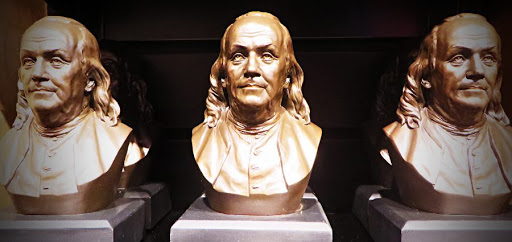
What's the best advice you can give to someone visiting Philadelphia's Liberty Trail (besides bringing your book!)?
Plan to spend 2-3 days exploring the area at a leisurely pace. There are so many historic things to see and do that many people overlook.
And everything is within walking distance, so there’s no need to rent a car.
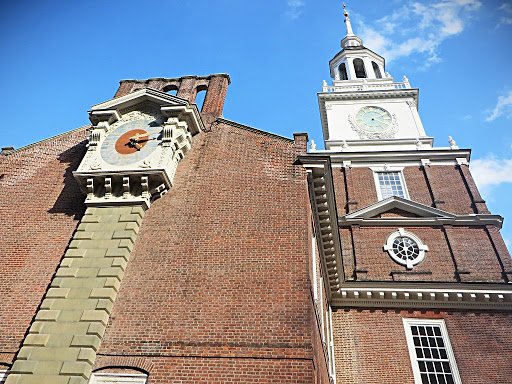
Clocks adorn all four sides of Independence Hall
Is there anything else you'd like to share with us?
When you want to see something a little more contemporary, head across town to climb the Rocky steps and pose with the Rocky statue!
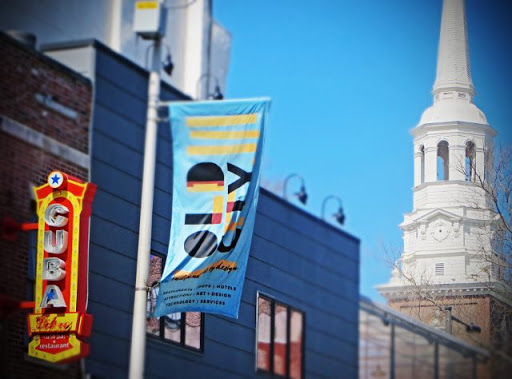
Old and new blend in the historic Old City neighborhood of Philadelphia
Note: We received a review copy of this book from the publisher, Globe Pequot - thank you!
All photos courtesy and copyright Larissa and Michael Milne
